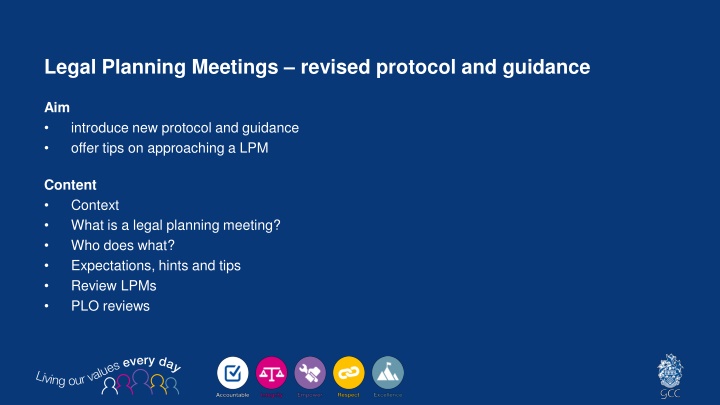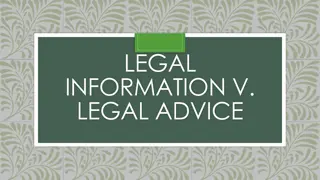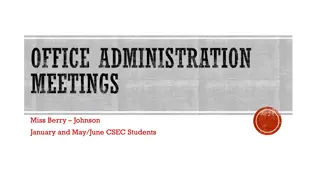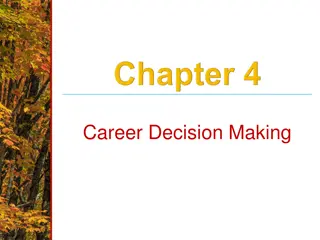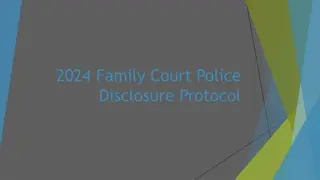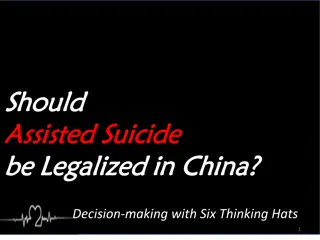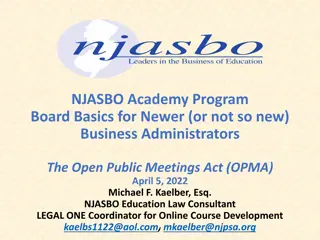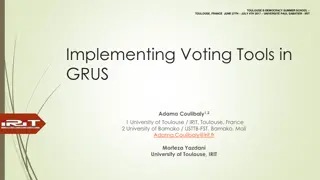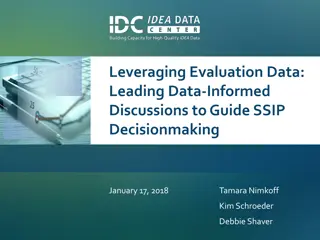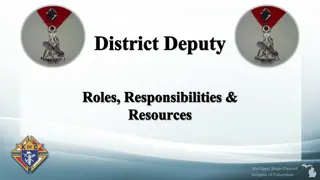Legal Planning Meetings Protocol and Guidance for Effective Decision-Making
Legal Planning Meetings (LPMs) play a crucial role in deciding next steps to safeguard children at risk. This revised protocol and guidance offer valuable insights into conducting LPMs effectively, outlining roles, expectations, and document requirements. With a focus on legal advice, evidence evaluation, and collaborative decision-making, this resource aims to enhance the process of determining child protection measures.
Download Presentation

Please find below an Image/Link to download the presentation.
The content on the website is provided AS IS for your information and personal use only. It may not be sold, licensed, or shared on other websites without obtaining consent from the author.If you encounter any issues during the download, it is possible that the publisher has removed the file from their server.
You are allowed to download the files provided on this website for personal or commercial use, subject to the condition that they are used lawfully. All files are the property of their respective owners.
The content on the website is provided AS IS for your information and personal use only. It may not be sold, licensed, or shared on other websites without obtaining consent from the author.
E N D
Presentation Transcript
Legal Planning Meetings revised protocol and guidance Aim introduce new protocol and guidance offer tips on approaching a LPM Content Context What is a legal planning meeting? Who does what? Expectations, hints and tips Review LPMs PLO reviews
Context First lockdown - Nicola Bennett (HMI, Ofsted) was seconded to GCC and undertook QA of LPM document bundles. She provided written and verbal feedback to social workers and team managers. Left us with good learning to help improvement.
What is a legal planning meeting (LPM)? Defined in statutory guidance key part of Public Law Outline. Purpose to get legal advice and consider next steps when there isn t enough progress to protect the child. Make a decision in principle about whether the threshold criteria have been met Decide whether pre-proceedings or proceedings are necessary in the best interests of the child. Identify any evidence gaps, clarify whether additional assessments will be required, and consider what would be a suitable draft care plan for the child. LPMS also consider and test the evidence for proposals to seek revocation of a Care Order, Supervision Order or Placement Order, or extend a Supervision Order. A set agenda. Found in the LL document Legal Planning Meeting Agenda and Record.
Expectations - summary You believe progress isn t enough to protect a child from harm. Discuss concerns with your team manager. Be clear about the evidence of lack of progress. Team manager may agree LPM is needed or ask you to gather more information or complete further tasks. If child is already on CP plan, you or your TM should seek views of the conference chair. [NB: accountability for making formal LPM request lies with the TM.] TM consults SM. Once TM agrees LPM may be needed, complete and collate the necessary document bundle (more on this in the following slides). Agreement to LPM rests with HoS.
Who does what? LPM members and roles Social worker and team manager: set out the concerns, highlighting and summarising key evidence in relation to the threshold criteria. Legal adviser: evaluate evidence and provide privileged legal advice on whether it is sufficient to conclude threshold is reached. Head of service. Convene and chair meeting, ensuring all voices are heard; confirm outcome including any instructions to the legal adviser. In doing so they must consider carefully the legal advice. Other participants: provide advice and challenge from the perspective of their own service remit.
Document bundle Other documents only where relevant. May include: neglect toolkit medical, parenting, cognitive and DOLS assessments current plan final evidence and fact finding from previous care proceedings minutes of the most recent strategy meeting, child protection conference or looked after child statutory review. SW s PLO summary Replaces Basic Info template Up-to-date genogram Up-to-date chronology Up-to-date single assessment Draft SWET if recommendation is to issue
Document bundle: PLO summary Summarises for the LPM the case for arguing the threshold criteria are met. What are the big issues for the child? the nature of the significant harm caused or likely evidence of that harm and impact interventions so far with an analysis of why they have not worked options; and proposed next steps, with reasons. Includes basic information about the child and their family Consideration of permanence and FGCs (plans or outcomes)
Document bundle: genogram Should show minimum of three generations more if relevant. Done well, it provides an at-a-glance understanding of significant relationships in a child s life and aids analysis and planning. Show current and past relationships, names, and dates of birth. Show who the child lives with. Helpful to annotate it to show significant information, such as supportive relationships, domestic abuse risks and if an individual is in prison. Example next slide
Peter Smith snr. Died 2018 RSO Arnold Sharp 30/04/65 Mary s adoptive parents Madge Sharp 15/06/69 Strong relationship. Lives nearby, provides day to day support Paul Jones 21/03/87 Peter Smith jnr. 14/06/87 Mark Smith 27/05/88 Lucy Jackson O4/04/95 No contact Mary Smith 18/04/84 Susan Lott Domestic abuse risk In prison; due out (date). Risk of sexual harm to children Ellie Smith 14/07/10 Daniel Jones 10/10/19 Half-brother to Emma and Emily Emma Jones 23/04/09 Emily Jones 15/09/13
Document bundle: chronology Up-to-date Needs to show key eventsin the child s life and their impact. The evolution of concerns, responses, progress or lack of progress, impact on child, outcomes and decisions should be clear and illustrate how we got to this point. Don t overlook significant events from other agencies involvement: for example: evidence of missed dental and medical appointments for chronic conditions when considering child neglect; prosecution of parents for persistent unauthorised school absence; police involvement, arrests and convictions; parental mental health crises. It can be valuable to include aspects of the parents own chronologies, especially trauma subject to relevance to the child and consent. Do not assume the Liquid Logic chronology will be good enough for LPM. These may be too long, with too many entries that do not describe key events; or too brief, with key events missing. It is worth taking time to develop a good chronology as it will save time later.
Document bundle: single assessment Up to date Can be pre-birth assessment where appropriate Relevant information and analysis informed by the Jones risk assessment tool and where relevant the neglect toolkit Explain why it has become necessary to request a LPM Clear understanding of the child s circumstances as they are, not as they were understanding impact of past and present risk on the child today Concrete evidence of impact; research to evidence likely impact Balanced view reflect both concerns/risks and strengths Child s voice. What do they think about their life? What is a day in their life like? Parenting capacity behaviours and evidence of ability to meet needs in short and long term Information and professional opinion from other agencies
Document bundle: other documents Don t overdo it Avoid the temptation to throw everything at the LPM. Relevance is much better than volume. Only provide additional documents that add to understanding of the child s situation and legal threshold, and that aren t summarised clearly in the single assessment. May include medical, parenting, cognitive and DOLS assessments child s current plan final evidence and fact finding from previous care proceedings minutes of the most recent strategy meeting, child protection conference or looked after child statutory review neglect toolkit
At the LPM Prepare well. Be ready and able to say what it is about the child s story, what you are proposing and why we need the outcome proposed. Use the social work PLO summary to structure your input, drawing on evidence from your other docs to support your arguments. Be clear about evidence in relation to threshold criteria. Be clear about the child s experiences and their impact on the child actual (concrete evidence) and likely (research). Be clear about what we ve done with what effect (or lack of). Be ready to be challenged and respond to challenge. It s better to test your case and arguments fully in LPM than get caught on the hop in court.
Theme LPMs within LPM Panel (formerly Legal Gateway) Purpose Make decisions against threshold to Enter pre-proceedings Issue proceedings (including children already s20) Revoke Care Order Supervision Order Placement Order Extend a Supervision Order Participants Required in all circs Social worker Team manager Locality HoS Legal adviser Documentation NEW Social Worker s PLO Summary (replaces Basic Information Sheet) Up to date genogram Up to date chronology Up to date single assessment Social work evidence template (draft) where the recommendation is to issue proceedings Other documents only as relevant Others as relevant Team manager, Family and Friends Assessment and Support Team Team manager from the Under 11s Permanence Team; Team manager from the 11 Plus Permanence service; manager from the Edge of Care Service; TACS Service Manager Review LPMs Decides against threshold whether to step down from pre-proceedings step up from pre-proceedings to issue care proceedings extend pre-proceedings Required in all circs Social worker Team manager Locality HoS Legal adviser (the same legal advisor who was at the LPM or who has provided advice during pre- proceedings if different). NEW Social Worker s PLO Summary (replaces Basic Information Sheet) Other documents only as relevant, for example a recent parenting assessment if undertaken. There is no expectation of a new single assessment unless one has been undertaken. Takes place in all cases of pre-proceedings in or before Week 20. Where circumstances change or new evidence emerges indicating a different direction may be required, a review should take place as soon as possible (having regard to risk). It should not wait until Week 20. That is a limit, not a target.
